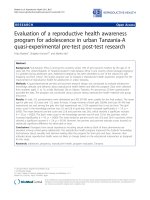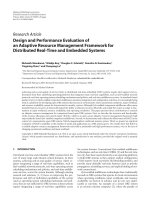Performance evaluation of a power operated wetland weeders for paddy
Bạn đang xem bản rút gọn của tài liệu. Xem và tải ngay bản đầy đủ của tài liệu tại đây (396.18 KB, 7 trang )
Int.J.Curr.Microbiol.App.Sci (2019) 8(4): 2266-2272
International Journal of Current Microbiology and Applied Sciences
ISSN: 2319-7706 Volume 8 Number 04 (2019)
Journal homepage:
Original Research Article
/>
Performance Evaluation of a Power Operated Wetland Weeders for Paddy
N.K. Sathish Kumar* and A.P. Mohankumar
Department of Farm Machinery and Power Engineering, Agricultural Engineering College
and Research Institute (TNAU), Trichy, India, 621712
*Corresponding author
ABSTRACT
Keywords
Plant damage
efficiency,
Performance index,
Weeding efficiency,
Effective field
capacity, Fuel
consumption
Article Info
Accepted:
17 March 2019
Available Online:
10 April 2019
Generally farmers prefer manual weeding due to the lack of awareness about the
mechanical weeder. But manual weeding is a most laborious and time consuming
process. Nowadays mechanical weeders are being promoted to reduce drudgery,
time of operation and to overcome the lack of labours problem. The study has
been conducted on sandy loam and clay loam soils to evaluate the performance of
two mechanical power weeders i.e., Garuda power weeder and Japanese power
weeder. From the results, Garuda weeder has the highest weeding efficiency of
68.62 and 76.92 % and lowest plant damage of 24 and 13.33 % for sandy loam
and clay loam soils. Japanese weeder has highest and lowest field capacities of
0.173 ha hr-1 for sandy loam soil and 0.067 hahr-1 for clay loam soil. The
performance index indicates that Garuda weeder and Japanese weeder is suitable
for sandy loam and clay loam soils respectively.
Introduction
Rice is the staple food for more than half of
the world’s population. In paddy farming,
weeds are competing with crops and it leads
to decrease in yield. Weeds decline the crop
yields from 15 to 50 percent influenced by the
species, density and weeding period (Mirza et
al., 2009). So, timely weeding operation is
essential for the paddy crop to control the
weeds and to upturn the productivity. About
33 percent cost of cultivation is consumed on
weeding alone when supported with the
manual weeding. There are different types of
weeding followed in paddy cultivation viz.,
chemical
weeding,
manual
weeding,
mechanical weeding. Chemical weeding uses
weedicides to kill the weeds and it is a little
costliest method. Manual weeding is an
accurate weeding method which results in a
complete removal of weeds. Manual weeding
is a time consuming and higher labour
requirement process (Mahilang et al., 2017).
Mechanical weeding is weed control
technique that manage weed populations
through remove, injure, kill, or make the
growing conditions unfavorable for weeds.
Efficient mechanical weeding for paddy is
performed only on the System of Rice
Intensification (SRI) methods of transplanted
2266
Int.J.Curr.Microbiol.App.Sci (2019) 8(4): 2266-2272
fields. It will not suitable for the
conventionally transplanted fields. Keeping
the above facts in view, selecting better
weeder with region specific, commercially
available two power weeders i.e., Garuda
weeder and Japanese weeder were selected
for performance evaluation under field
conditions.
Materials and Methods
computed by using the formula (Keshavalu et
al., 2017).
EFC = A / T
Where
EFC
A
T
– Effective field capacity (ha hr-1)
– Area covered (ha)
– Time taken to cover the area (h)
The study was conducted to evaluate the
performance of two mechanical power
weeders i.e., Garuda power weeder and
Japanese power weeder. Both the weeders
were evaluated for its performance during the
weeding periods. The weeding was done at
20th day after the transplanting of paddy in
sandy loam soil at Tamil Nadu Agricultural
University, Agricultural Engineering College
and Research Institute, Kumulur(10°55’ N
and 78°49’ E)and another trail was done in
clay loam soil at Tamil Nadu Rice Research
Institute (TRRI), Aduthurai (11°00' N and 79°
28'E) . The row spacing adopted in the field
was 20 x 20 cm & 20 x 18 cm. Various
parameters were selected to evaluate the
performance of selected power weeders on
field conditions. The parameters are
Weeding efficiency
Effective Field capacity
Weeding efficiency
Plant damage efficiency
Fuel consumption
Performance index
Plant damage efficiency
The specifications of selected two row power
weeders are given in table 1.
Effective field capacity
It is the machines ability to do a job in a field
conditions. It includes the time for turning in
headlands, blade cleaning time when weeds
clogged to the blade. It is expressed in hectare
per hour (ha h-1).Effective field capacity is
It is the ratio between the number of weeds
removed by the weeder to the number of
weeds present before weeding. A plot of 1 x 1
m was marked in the field and the weeds were
counted before and after the weeding process.
It is expressed in percentage (%). Weeding
efficiency is computed by using the formula
(Sabaji et al., 2014)
WE = ((W1 – W2) / W1) x 100
Where
WE - Weeding efficiency (%)
W1
- Number of weeds present before
weeding
W2
- Number of weeds present after
weeding
It is the ratio between the number of plants
damaged by the weeder to the number of
plants before weeding process. A plot of 1 x
1m was marked in the field and the plants
were counted before and after the weeding
process. It is expressed in percentage (%).
Plant damage is computed by using the
formula (Sabaji et al., 2014).
PD = (P1 – P2) / P1 x 100
Where
PD
2267
- Plant damage (%)
Int.J.Curr.Microbiol.App.Sci (2019) 8(4): 2266-2272
P1
- number of plants in 1m2 plot
P2
- number of plants damaged after
weeding
of Garuda and Japanese power weeder is
shown in figure 1 and 2. The results observed
were as follows
Fuel consumption
Weeding efficiency
It is the quantity of fuel refilled in the tank
after a period of time. Initially a fuel tank is
fully filled with fuel, the machine is allowed
to run for 1 hour and refill the fuel tank using
a measuring jar. It is expressed in litres per
hour (l h-1).Fuel consumption is computed by
using the formula (Keshavalu et al., 2017)
From the field trail, the weeding efficiency
were observed as for sandy loam and clay
loam soils were 68.62 and 76.92 % for
Garuda weeder and 64.58 and 76.19 % for
Japanese weeder respectively. The weeding
performance of Garuda and Japanese weeder
in clay loam soil is higher when compared to
sandy loam soil due to soil consistency. This
leads to the easy cutting and removal of
weeds.
FC = Q / T
Where
Plant damage efficiency
FC - Fuel consumption (l h-1)
Q - Quantity of fuel refilled in the tank (l)
T - Total running time of an engine (h)
PI = (EFC x (100 – PD) x WE) / P
From the field trail, the Plant damage
efficiency were observed as for sandy loam
and clay loam soils were 24 and 13.33 % for
Garuda weeder and 28 and 20 % for Japanese
weeder. The plant damage efficiency of
Garuda and Japanese weeder in clay loam soil
is lower when compared to sandy loam soil
due to soil consistency. This leads to the easy
cutting action of blades to follow its
trajectory, hence the weeders doesn’t deflect
from the passage line. So the efficiency of
plant damage gets lowered.
Where
Effective field capacity
Performance index
It is the measure of machine performance how
good the machine is adapted to a specific field
condition with respect to power input. It is
expressed in hectare per hp (ha hp1
).Performance index was computed by using
the formula (Sabaji et al., 2014)
PI
EFC
PD
WE
P
(hp)
- Performance index (ha hp-1)
-Effective field capacity (%)
- Plant damage (%)
-Weeding efficiency (%)
-Power required to operate the weeder
Results and Discussion
Both the weeders were evaluated for its
different evaluation parameters under
different field conditions. The field operation
From the field trail, the effective field
capacity were obtained as for sandy loam and
clay loam soils were 0.160 and 0.090 ha h-1
for Garuda weeder and 0.173 and 0.067ha h1
for Japanese weeder. The effective field
capacity of Garuda and Japanese weeder in
clay loam soil is lower when compared to
sandy loam soil due to field conditions. Field
condition reduces the forward action of the
weeders by not providing sufficient traction to
the blades.
2268
Int.J.Curr.Microbiol.App.Sci (2019) 8(4): 2266-2272
Table.1 Specifications of machine used in field trial
S.No
Description
1
2
3
4
5
6
7
Model
Power, kW
Transmission type
Width of cut, m
Blade type
No. of rows
No. of blades on each flange
Specifications
Garuda Weeder
Japanese Weeder
Sharp Garuda 3PT 250
1.4
1.4
Worm and wheel type gear Worm and wheel type gear
0.4
0.4
L type
Finger type
2
2
8
12
Fig.1 Field operation of Garuda weeder
Fig.2 Field operation of Japanese weeder
2269
Int.J.Curr.Microbiol.App.Sci (2019) 8(4): 2266-2272
2270
Int.J.Curr.Microbiol.App.Sci (2019) 8(4): 2266-2272
1
Fuel consumption
From the field trail, the fuel consumption
were observed as for sandy loam and clay
loam soils were 0.44 and 0.52lph for Garuda
weeder and 0.35 and 0.47lph for Japanese
weeder. The fuel consumption of Garuda and
Japanese weeder in clay loam soil is lower
when compared to sandy loam soil due to
field conditions. Field condition reduces the
forward action of the weeders by not
providing the traction to the blades.
Performance index
From the field trail, the performance index
were recorded as for sandy loam and clay
loam soils were 406.60 and 300 ha hp-1for
Garuda weeder and 267.84 and 305.54ha hp-
for Japanese weeder. The performance index
of a Garuda weeder indicates that it is suitable
for sandy loam soils and performance index
of a Japanese weeder indicates that it is
suitable for clay loam soils.
In conclusion, two power weeders were
evaluated under two different soil conditions
i.e. sandy loam and clay loam soil. Weeding
efficiency, Plant damage, Fuel consumption,
Effective Field Capacity and Performance
Index were evaluated. From the results,
Garuda weeder has the highest weeding
efficiency of 68.62 & 76.92 %and lower plant
damageof24 & 13.33 %for sandy loam and
clay loam soils. Japanese weeder has highest
field capacity of 0.173 ha hr-1 for sandy loam
soil and in the clay loam soil it has the lower
field capacity of 0.067 ha hr-1 due to the
2271
Int.J.Curr.Microbiol.App.Sci (2019) 8(4): 2266-2272
sinkage problem. The performance index of a
Garuda weeder indicates that it is suitable for
sandy loam soils and performance index of a
Japanese weeder indicates that it is suitable
for clay loam soils.
References
Mirza Hasanuzzaman, M., Ali M H, Alam M
M, Akther M, Alam K F. (2009).
Evaluation of pre-emergence herbicide
and hand weeding on the weed control
efficiency and performance of
transplanted Aus rice. AmericanEurasian J. Agron, 2(3): 138-143.
Keshavalu, Prasan Patil, B, Raghavendra V
and Shafat khan. (2017). Performance
evaluation of wetland power weeder
for paddy. Asian Journal of
Agricultural Extension, Economics
and Sociology, 18(3): 1-8.
Kumar, Anil Kumar and Dileep Sean. (2017).
Performance evaluation of power
weeder under dry and wetland
conditions. International Journal of
Agriculture Innovations and Research,
6(2).
Mahilang, Choudhary, Victor, Naresh and
Sonboier.
(2017).
Design
and
development of power operated paddy
weeder for rice. Current Journal of
Applied Science and Technol, 24(5):
1-7.
Narwariya, Tiwari and Shrivasatava. (2016).
Performance evaluation of different
manually operated weeding equipment
for paddy crop in versitols. Ecology,
Environment
and
Conservation,
22:S357 – S363.
Sabaji, T D., Sahoo P K, Dipankar De and
Mir Asif Iquebal (2014). Design and
development of ridge profile power
weeder. Journal of Agricultural
Engineering, 51(4).
How to cite this article:
Sathish Kumar, N.K. and Mohankumar, A.P. 2019. Performance Evaluation of a Power
Operated Wetland Weeders for Paddy. Int.J.Curr.Microbiol.App.Sci. 8(04): 2266-2272.
doi: />
2272









